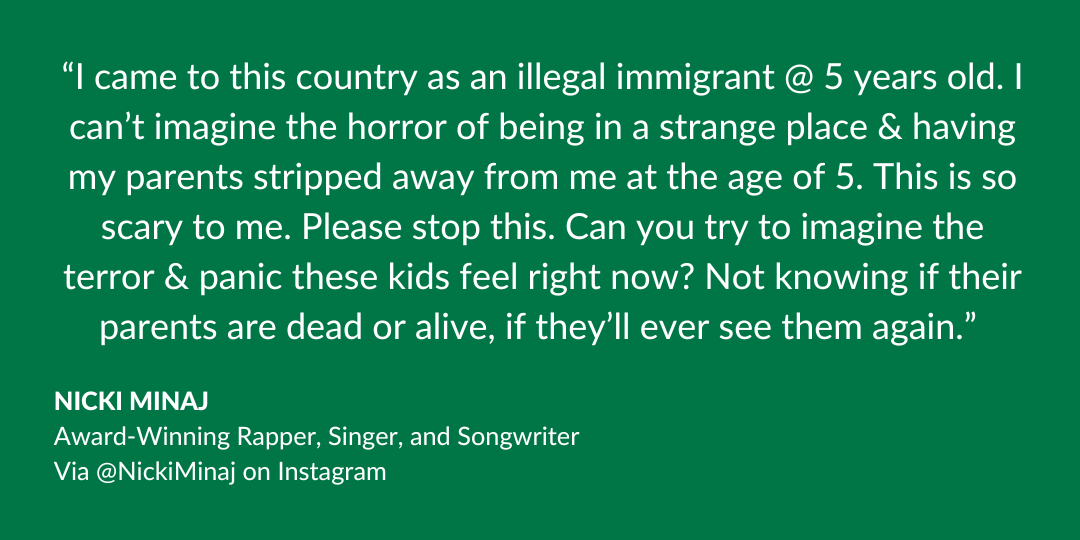Twenty-nine parents who were separated from their children and removed to their home countries in Central America last year traveled to the US/Mexico border last month with the hope of reuniting with their children in the US. The twenty-nine parents, some who have been separated from their children for nearly a year, presented themselves at the US/Mexico border on March 2. The parents asked to be allowed back into the US to resume their asylum applications and to be reunited with their children, who are in American foster homes, shelters, or with relatives.
Read moreThe Washington Post: “Parents separated from their kids returned to the U.S. to be reunited. They’ve been detained for almost a month.”
Washington Post: “Fact-checking President Trump’s Oval Office address on immigration.”
Last week President Trump addressed the nation in a speech about immigration and what he has claimed is a “crisis” at the US-Mexico border. Throughout the course of his nine-minute speech (which was made on the 18th day of the government shutdown), numerous fact-checkers and experts agree that the president painted an exaggerated and overall misleading picture of immigration to the US and the situation at the US-Mexico border. Fact-checkers across mediums confirm that the President’s speech pumped up some numbers, exaggerated the public safety risks of immigration, and repeated false claims regarding funding for the border wall.
Read moreWhat Is Immigration Jail Like?
Each day the United States detains tens of thousands of people in detention facilities and local jails throughout the country. More than 400,000 are detained (including border apprehensions) on average each year. People are detained in the border area in facilities run by Customs and Border Protection (CBP) as well as in privately-owned and operated facilities throughout the country that are contracted by Immigration and Customs Enforcement (ICE). ICE also contracts local jails throughout the country to hold detainees held during removal proceedings.
Read moreJon Stewart's 5 Best Moments on Immigration
In news that makes a lot of people very sad (including us), Jon Stewart is leaving the Daily Show in August after sixteen years as host. In a revealing and in-depth interview, he cited the weary prospect of covering the upcoming US election that led him to leave the show. While the Daily Show, of course, covered a wide variety of political and cultural topics, Stewart had many great and enlightening segments on immigration. And so as Comedy Central begins the goodbye to Jon Stewart by streaming 2,000 episodes of the show online beginning tomorrow, we thought it would be an opportune time to revisit the show's best immigration moments under Stewart's leadership. We're hopeful these types of segments will continue, because, fortuitously, the new Daily Show host is an immigrant himself.
Read moreThe Guardian: "UN says 800 migrants dead in boat disaster as Italy launches rescue of two more vessels"
A shipwreck this past weekend off the coast of Libya has led to the death of 800 migrants and has prompted calls for the European Union to address the worsening migrant crisis in Europe. The boat, which set sail from Tripoli and is one of many unseaworthy vessels that human smugglers use, contained nationals of Gambia, Ivory Coast, Somalia, Eritrea, Mali, Tunisia, Sierra Leone, Bangladesh and Syria, and included children between the ages of ten and twelve. With only a reported twenty-seven survivors, it is the worst such disaster in the Mediterranean Sea. Italian authorities arrested a Tunisian man who is believed to be the captain of the boat as well as a Syrian national, who were charged with human trafficking and the captain also charged with reckless multiple homicide. The overall migrant death toll in the Mediterranean Sea this year has already surpassed 1,500 victims—a drastic increase from the same period last year. The record number of migrants including children seeking haven in Europe is reminiscent of the US/Mexico border surge and crisis last year.
Italian rescuer Vincenzo Bonomo told La Repubblica: "'It was a sight that broke the hearts of even men of the sea like us. I saw children’s shoes, clothing, backpacks floating in the water. Every time we saw a shoe or a bag, any sign of life, we thought we might have found a survivor. But every time we were disappointed. It was heart-breaking[.]'"
In response, the European Union agreed after emergency meetings to launch military operations against the networks of smugglers in Libya deemed responsible for sending thousands of people to their deaths in the Mediterranean in addition to increasing maritime patrols as well as naval search-and-rescue missions. Anas el-Gomati, a researcher at the Sadeq Institute, a Libyan think-tank, questioned the effectiveness of the European response: "'Military action is a deterrent; it’s not a substitute for a coherent and robust policy...It will do nothing to stop the flow of migrants coming from sub-Saharan Africa and address the reasons as to why they choose to take a perilous route such as the western coast of Libya.'"
Nigerian refugee Hakim Bello, who previously survived the dangerous sea voyage and now lives in Berlin, called the Mediterranean Sea "the deadliest border in the world" and tried to explain what motivates migrants to undertake the dangerous journey: "We all have different reasons for doing it: some people think they’ll find a better life in Europe, others just want to get away from a war zone. But everyone feels they have no other option."
Prime Minister Joseph Muscat of Malta said: "'What happened on Sunday was a game changer...There is a new realization that if Europe doesn’t act as a team, history will judge it very harshly, as it did when it closed its eyes to stories of genocide—horrible stories—not long ago.'"

